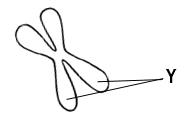So recall from our previous lesson video that before any cell can divide, it must first replicate or duplicate or make an extra copy of its DNA. And how the DNA is organized in the cell is very important. In this video, we're going to introduce the organization of DNA in the cell. What you'll notice is that throughout this video, we're going to introduce a whole bunch of different terms and notice that the terms that link directly to the image down below are labeled with these letters, and we have letters a, b, c, d, and e. Once again, these letters, labeling specific terms, are going to link directly to the letters that we have down below in our image. So, keep that in mind as we go through this video. The very first term we're going to introduce here is a term called the genome. The genome refers to the complete set of all of a cell's DNA, with "all" being the keyword. The genetic material is referring to molecules that determine the inherited traits of an organism, and usually when scientists use the term genetic material, they're referring to the DNA of the organism. Within a cell, the DNA is going to associate with proteins that are called histones. These histone proteins are going to form units that are called nucleosomes. Nucleosomes themselves can be defined as units of 8 histone proteins at the core with DNA wrapped around it.
To start to understand these terms, let's take a look at our image down below. We'll start here, with term A, the genetic material, DNA. Notice here we're showing you an image of DNA, as we've discussed in our previous lesson videos. A double-stranded helix of nucleotides as we see. Now within a cell, it turns out that the DNA is going to be organized into these units called nucleosomes. Nucleosomes form when DNA is wrapped around these histone proteins. Notice these little purple circles that you see throughout are histones, these histone proteins. The histone proteins will organize into these units of 8 histone proteins. The 8 histone proteins form the core of the nucleosome, and DNA will wrap itself around the histone protein, almost like taking the core of a pencil or a pen if that was the histone core, and taking a yarn and wrapping the yarn around the histone protein. Histone proteins at the core with DNA wrapped around it. Now, it turns out that within the cell, these nucleosomes can actually take different forms depending on if the cell is actually in a non-dividing state or if the cell is in a dividing state.
When the cell is in a non-dividing state, when the cell is not dividing, it turns out that the DNA, the nucleosomes, are going to be organized into what's known as chromatin. Chromatin represents loosely packed or coiled nucleosomes in non-dividing cells. But when the cell is about to divide in a dividing cell, the nucleosomes take a different form and they're no longer loosely packed or coiled. Instead, they're going to become tightly packed into what is known as chromosomes. Chromatin refers to loosely packed or coiled nucleosomes in a non-dividing cell. Chromosomes are referring to tightly packed or highly condensed nucleosomes in a dividing cell. Let's take a look at our image down below to get a better idea of this.
Notice on the left-hand side, what we're showing you is a non-dividing cell. Notice that within the nucleus of this non-dividing cell when you zoom in the DNA is organized in this format here, where the genetic material, the DNA, is wrapped around histone proteins to form these nucleosomes. These nucleosome subunits, these nucleosome units here, when the cell is in a non-dividing state, it's going to be in a loosely coiled state called chromatin. Over here in the non-dividing state, the DNA is in a chromatin form. The chromatin form, because it's so loosely coiled, you can really think of a ball of yarn that is really loosely coiled. But notice that, over here on the right-hand side, what we have is the dividing cell. The DNA is going to condense, and so we have condensing DNA here. The DNA condenses into highly condensed or tightly packed chromosomes. This term, chromosomes, you can think of a ball of yarn that is really, really tightly coiled, nicely wrapped around, unlike the ball of yarn that's over here.
Chromatin and chromosomes are both referring to DNA wrapped around protein. The difference is really that chromatin is going to be a more loose form of the DNA, found in non-dividing cells. Whereas chromosomes are going to be more tightly coiled, DNA found in dividing cells. This is going to be very important. This condensing of the DNA into chromosomes is going to be very important for moving the DNA around within a cell that is dividing. We'll get to talk a lot more about chromosomes and the dividing cell as we move forward in our course here. But for now, this here concludes our introduction to the organization of the DNA in the cell, and we'll be able to get some practice applying these concepts as we move forward in our course. See you all in our next video.


